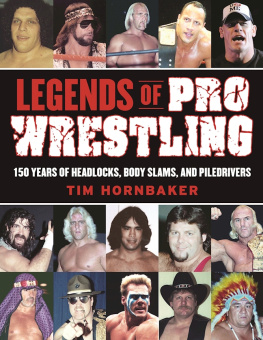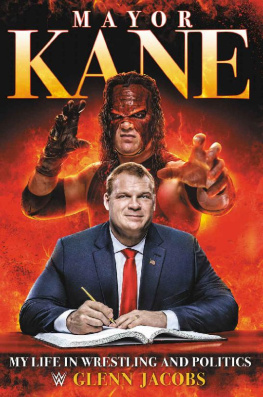Copyright 2012, 2016 by Timothy M. Hornbaker
All Rights Reserved. No part of this book may be reproduced in any manner without the express written consent of the publisher, except in the case of brief excerpts in critical reviews or articles. All inquiries should be addressed to Sports Publishing, 307 West 36th Street, 11th Floor, New York, NY 10018.
Sports Publishing books may be purchased in bulk at special discounts for sales promotion, corporate gifts, fund-raising, or educational purposes. Special editions can also be created to specifications. For details, contact the Special Sales Department, Sports Publishing, 307 West 36th Street, 11th Floor, New York, NY 10018 or .
Sports Publishing is a registered trademark of Skyhorse Publishing, Inc., a Delaware corporation.
Visit our website at www.sportspubbooks.com
10 9 8 7 6 5 4 3 2 1
Library of Congress Cataloging-in-Publication Data
Hornbaker, Tim. Legends of pro wrestling : 150 years of headlocks, bodyslams, and piledrivers / Tim Hornbaker ; foreword by Jimmy Superfly Snuka.
p. cm. Includes bibliographical references.
Previous edition ISBN: 978-1-61321-075-8 (pbk. : alk. paper)
1. Wrestling--Juvenile literature. I. Title. GV1195.3H67 2012 796.812--dc23
2012015014
ISBN: 978-1-61321-808-2
Printed in China
To my grandmother Virginia and my mother Barbara, who are both an inspiration in strength, courage, and unyielding love.
TABLE OF CONTENTS
I. The Pioneers Blaze a Trail
Pro Debut Between 1850 and 1920
A t the heart of the professional wrestling business, more important than the weekly television ratings, pay-per-view buy-rates, and even attendance numbers, are the wrestlers themselves, who, in many cases, have devoted their entire lives to the industry. At great personal risk, these men and women have stepped through the ropes to entertain audiences, and their profound love for the sport cannot be equaled by any other form of athletics. While grappling is a time-honored tradition of combat with roots in Ancient Greece and India, modern professional wrestling has rapidly evolved over the last 150 years, and the wrestlers themselves have transformed in many imaginative ways.
With courage and sensibility akin to bare knuckle fighters, wrestlers going back to the American Civil War were tough to the bone and adept at battling opponents in a raw, brutal fashion that ended with the toughest competitor winning. There was very little flashiness, no grand match entrances, and the wrestlers didnt achieve success because of their look or by the push of a promoter. At some juncture, and historians dont exactly know when, the sport went through an important metamorphosis, and wrestlers heightened their performance in matches with predetermined finishes. Audiences responded positively to the adjustment, although the modification of its genuineness was kept from fans. For those inside the business, the overhaul of the fundamental blueprint for wrestling was almost necessary to keep it relevant to the public. In fact, the implementation of creativity into what used to be exhaustively contested matches that could last hours turned wrestling into a multi-million dollar business.
Colonel McLaughlin, William Muldoon, Tom Jenkins, and Farmer Burns were key athletes during the latter part of the 1800s. They were world-class wrestlers in both the Greco-Roman and catch-as-catch-can styles and had a heavy influence on the next generation of wrestlerswhich included Frank Gotchthe greatest American wrestling champion in history. Through shear invincibility and magnetism, Gotch garnered mainstream attention in the 1900s and 1910s, and made professional wrestling respectable for middle- to upper-class followers. He was an indomitable spirit, and his legitimate wrestling knowledge, quickness, and aggressiveness made him unbeatable. Gotch was also able to work matches and create tension-filled situations that kept fans on the edge of their seats. Gambling was prevalent during this time-frame, and Gotch was as informed as anyone when it came to making money.
The business turned toward three men during the mid-to-late 1910s: Ed Strangler Lewis, Earl Caddock, and Joe Stecher. Each brought a unique personality and talent to the ring, and continued to build upon the strengths forged by their predecessors. Forward-thinking promoters were trying to stay ahead of the game by implementing intriguing concepts and introducing new wrestlers whod keep the sport popular. Gimmicks and vociferous hype were on wrestlings doorstep, and fans embraced both the perceived competitive nature of the sport and the theatrical atmosphere of vaudeville. It all combined to create a world-wide phenomenon that is still being appreciated today.
Make no bones about it, anyone who undertakes the painstaking journey as a pro wrestler should be lauded for their commitment. Legends of Pro Wrestling honors the men and women who have awed and inspired fans everywhere through their actions on the wrestling mat, and these heroes will forever be cherished.
Americus

Photo Courtesy of the Collection of Steve Yohe
Born: | December 25, 1883 |
Height: | |
Weight: | |
Real Name: | August John Schoenlein |
Career Span: | 190221 |
Died: | July 17, 1958, Bowleys Quarters, MD 74 years old |
Titles Won: | At least 3 |
Days as World Champion: | |
Age at first World Title Win: | |
Best Opponents: | Frank Gotch, Stanislaus Zbyszko, Fred Beell |
A natural athlete from an early age, Gus Schoenlein grew up in Baltimore, Maryland, the son of German parents. When he began wrestling professionally, after a successful stint as an amateur, he adopted the name Americus to hide his occupation from his father, who wanted him to follow in his footsteps and become a building contractor. But Americus enjoyed the challenge of wrestling, and although he was but 145 pounds when he started, he was fearless against larger opponents. He was quick, aggressive, and possessed astonishing conditioning, able to wrestle matches lasting several hours in length. Through the yearsand as he gained weighthe advanced through the various divisions, finally winning the World Light Heavyweight Title twice, the first time over Fred Beell in 1908 and then over Charles Olson in 1910. On March 13, 1914, he beat Beell again, this time for the World Heavyweight crown in a match supported by the retired champion, Frank Gotch. His reign was brief, losing to Stanislaus Zbyszko less than two months later. Upon retirement, he finally joined his fathers contractor business while also coaching both the Maryland State Police in hand-to-hand combat and Princetons wrestling squad.
Beell, Fred

Photo Courtesy of the Pfefer Collection, Department of Special Collections, University of Notre Dame











